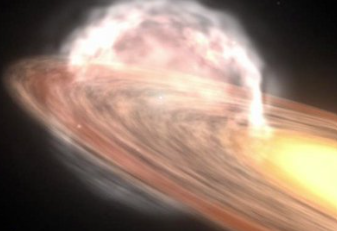Skywatchers just can’t wait for the event. Get those telescopes ready!
This summer, stargazers are in for a spectacular treat as T Coronae Borealis (T CrB), nestled in the Corona Borealis constellation, is predicted to undergo its first nova of the millennium. Known as a recurring nova, T CrB is a binary star system consisting of a white dwarf and an aging red giant. The proximity of these two stars creates a dynamic celestial interaction that leads to dramatic nova events approximately every 80 years, with the last one recorded in 1946.
T CrB’s nova phenomenon occurs when the red giant sheds material that forms an accretion disk around the white dwarf. Over time, this material builds up and heats until a critical temperature triggers a thermonuclear runaway, causing a brilliant explosion of light. This summer’s anticipated nova follows a predictable pattern noted by astronomers; the star began to dim in March 2023, signaling the upcoming explosive brightening, which is expected to occur by September.
𝐒𝐏𝐀𝐂𝐄:🪐 Cosmic Explosion, A rare eruption of light from a dead star called NOVA will likely be visible to people with the naked eye on Earth this summer in a fleeting but potentially stark celestial display that scientists are calling “a once-in-a-lifetime event.” pic.twitter.com/oHtIYbGklp
— Nepal Correspondence (@NepCorres) June 13, 2024
Unlike most novae, which are too dim and distant to be observed with the naked eye, T CrB’s upcoming display promises to be exceptional. The star is expected to reach a magnitude of 2, similar to that of Polaris, the North Star, making it visible without the aid of telescopes or binoculars for a few days. This visibility makes it a rare opportunity for both amateur and professional astronomers to witness a nova event so clearly.
Dr. Elizabeth Hays, head of NASA’s Astroparticle Physics Laboratory, highlighted the significance of this event, noting that nova events are typically faint and difficult to pinpoint. The proximity and brightness of T CrB’s nova will allow for detailed observation and study. This event is set to draw the attention of multiple space observatories, including NASA’s Fermi Gamma-ray Space Telescope, Neil Gehrels Swift Observatory, Imaging X-ray Polarimetry Explorer (IXPE), Nuclear Spectroscopic Telescope Array (NuSTAR), Neutron star Interior Composition Explorer (NICER), and the James Webb Space Telescope. The European Space Agency’s Extreme Universe Surveyor (INTEGRAL) and the National Radio Astronomy Observatory’s Very Large Array will also participate in monitoring the nova.
https://t.co/01NCqIeuWG
Astronomers await the rare ‘Blaze Star’ this summer
The ‘recurrent nova’ will be visible for about one week this summer
It’s actually two stars: a white dwarf and a red giant
‘A once-in-a-lifetime event, says NASA— Tom Souther (@TomSouther1) June 11, 2024
These observatories aim to gather data on the transfer of mass between the stars in the binary system and the details of the thermonuclear process that drives the nova. This coordinated effort will expand our understanding of such stellar phenomena and enhance the nova canon, which details these rare cosmic events.
The nova of T CrB not only offers a visual spectacle but also serves as an important scientific event that can provide insights into stellar processes and the life cycle of stars. As the summer progresses, astronomers and stargazers alike are eagerly anticipating what promises to be one of the most accessible and striking nova observations in recent history.
Key Points
i. T Coronae Borealis (T CrB), located in the Corona Borealis constellation, is set to undergo its first nova of the millennium this summer, visible to the naked eye.
ii. The binary star system, consisting of a white dwarf and an aging red giant, experiences novae approximately every 80 years, with the last event occurring in 1946.
iii. The upcoming nova, expected by September, is a result of material from the red giant forming an accretion disk around the white dwarf, eventually igniting in a brilliant explosion of light.
iv. T CrB’s nova is predicted to reach a brightness magnitude of 2, akin to Polaris, making it a rare opportunity for both amateur and professional astronomers to observe a nova without telescopes.
v. Multiple observatories including NASA’s Fermi Gamma-ray Space Telescope and the James Webb Space Telescope will study the nova, aiming to gather detailed data on the mass transfer between stars and the thermonuclear processes involved.
Charles William III – Reprinted with permission of Whatfinger News



